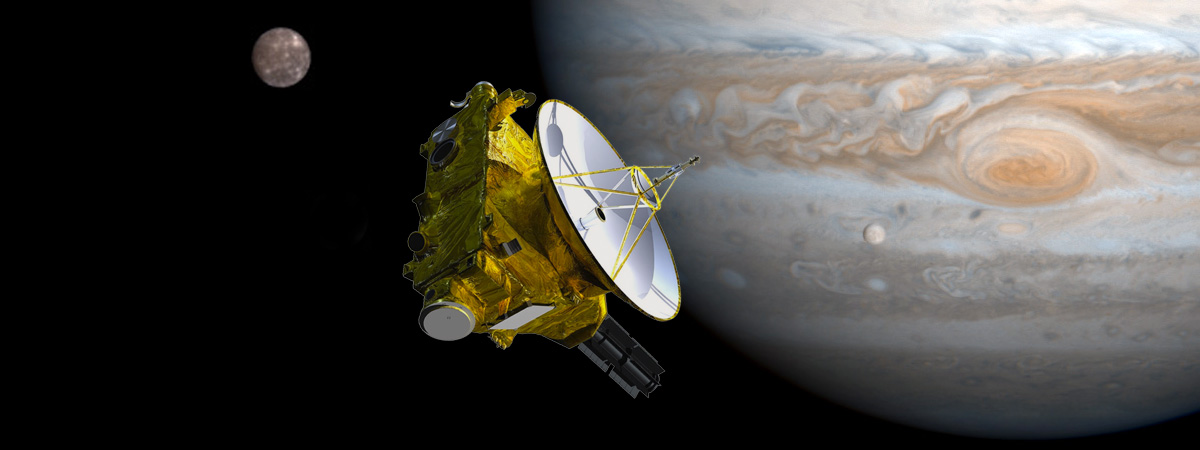New Horizons is a space vehicle developed by NASA and destined to be the first reconnaissance mission to the most famous dwarf planet (Pluto), its five moons (Charon, Hydra, Nix, Kerberos and Styx) and various Kuiper belt objects.
The mission’s objective is to understand the formation of the Plutonian system, the Kuiper belt, and the transformation of the early Solar System. The spacecraft has already collected data on the atmospheres, surfaces, interiors, and environments of Pluto and its moons. It will also study other objects in the Kuiper belt. Its specific missions consist of characterising the geology and morphology of Pluto and Charon, mapping their compositions and surface temperatures, characterising Pluto’s neutral atmosphere and its escape rate, determining whether Charon has an atmosphere, obtaining high-resolution images, and conducting similar research on Kuiper belt objects.
The New Horizons probe is discovering unknown objects , giving us information about the early Solar System and its evolution to the present day.
The probe was launched from Cape Canaveral (United States) on January 19th, 2006, and is currently in the Kuiper belt, 44 astronomical units (6.6 billion kilometres) away from Earth (or 44 times farther away than the Earth is from the Sun).
The spacecraft has a total take-off mass of 478.4 kilograms, its dimensions are 0.7 x 2.1 x 2.7 metres (comparable to the size of a grand piano), and it is triangular. Due to the great depth of space and the lack of sunlight it will encounter, the New Horizons probe is powered by a radioisotope thermoelectric generator (RTG), which produces electrical energy through the conversion of thermal energy generated by the decay of a radioactive substance. Its thermal control system was a crucial factor, due to the extremely low temperatures found in the regions of the solar system it is travelling to. As heat is only transmitted via radiation in space (there is no convection or conduction due to space being almost a perfect vacuum), it was covered in a lightweight golden multi-layer blanket to prevent the heat generated by the equipment from being lost in space. This was enough to keep all systems within the operating temperature range.
Its payload includes seven different systems that capture different aspects of the Plutonian system: ALICE (4.5 kg) captures images in the ultraviolet spectrum. It determines the atmospheric composition and internal structure of celestial bodies. RALPH (10.3 kg) captures images in the visible and infrared spectrum. It determines surface composition and temperature mapping. REX (0.1 kg) captures radio waves. It determines atmospheric temperature and pressure. LORRI (8.8 kg) consists of a high-definition camera installed in a telescope. It obtains high-definition images of the bodies being studied. SWAP (3.3 kg) is a solar wind detector. It determines Pluto’s interactions with solar wind. PEPSSI (1.5 kg) is an energetic particle spectrometer. It looks for neutral atoms that escape Pluto’s gravity and are charged due to their interaction with solar wind. Lastly, VB-SCD (1.9 kg) detects microscopic dust grains produced by collisions between asteroids and comets.
New Horizons travelled for a little over a year to get to Jupiter (February 2007), collect data from the different bodies that make up the Jovian system, and obtain enough gravity assist to continue its journey towards Pluto. In March 2015 it began to carry out reconnaissance manoeuvres on the planet, and it continued to do so for almost six months, until July 2015. During that period, New Horizons managed to map Pluto and its five moons. After successfully completing its main mission, the space probe headed towards the Kuiper belt object 2014 MU69 (now known as Ultima Thule), which it reached on 1st January 2019. This is considered the most distant object from Earth ever visited by a human object. Currently, the New Horizons probe is entering the unknown Kuiper belt, hoping to detail more objects in this area of the solar system.
The New Horizons probe has made many discoveries about Pluto and its system of moons. Thanks to the data still being received, researchers continue to draw incredible new conclusions. In addition, hitherto unknown objects from the Kuiper belt are being detailed, giving us information about the early Solar System and its evolution to the present day. This is of vital importance if we want to understand how our planet’s environment will continue to evolve, and possibly one day expand our borders beyond planet Earth.
The Pluto controversy
In August 2006, a few months after launching the New Horizons probe into space, the International Astronomical Union (IAU) downgraded Pluto’s status from planet to dwarf planet. This was due to Pluto not meeting the three requirements for an object within the solar system to be considered a planet:
- It must orbit around the Sun, not another body.
- It must have enough mass for gravity to force it into a spherical shape, to the point that it reaches hydrostatic equilibrium (basically, it must be a sphere).
- Its gravity must have cleared away most smaller objects from the vicinity of its orbit.
Of course, Pluto revolves around the Sun and is spherical; the requirement that it does not meet is that it has not cleared its vicinity of smaller objects. However, there is still great controversy surrounding this. Pluto’s orbit is very far away, and within the Kuiper belt. The number of objects it must attract by force of its gravity and the vicinity it must clear are much larger than that of the rocky planets (Venus, Earth and Mars). In fact, if any one of them had been in Pluto’s orbit, they would also have had serious difficulties in clearing the entire vicinity. However, Venus, Mars or the Earth itself would not have been downgraded from a planet status if they had been in Pluto’s orbit; this is why many researchers disagree with the IAU’s decision and argue that Pluto’s status as a planet should be restored.
The voyage of the New Horizons probe may not provide much more evidence to resolve this controversy, but it is still exploring a world that until recently has been completely opaque to human knowledge.



